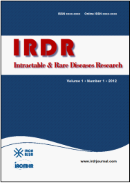Drug Discov Ther. 2009;3(2):62-70.
Beneficial effects of combined administration of sodium molybdate with atorvastatin in hyperlipidemic hamsters.
Ahmed AA
This study aims to evaluate the benefit of combined administration of sodium molybdate with atorvastatin in management of hyperlipidemia. Hyperlipidemic male Serian golden hamsters were administered either atorvastatin (40 or 80 mg/kg, p.o.) sodium molybdate (100 mg/kg, p.o.) or combination of atorvastatin (40 mg/kg, p.o.) with sodium molybdate (100 mg/kg, p.o.) for 30 consecutive days. Blood lipids (total cholesterol, triglycerides, HDL-cholesterol, Non-HDL-cholesterol and anti-atherogenic index) in addition to the activities of liver transaminases (AST, ALT), as well as antioxidant status (lipid peroxidation, catalase, glutathione peroxidase) were estimated before and after 15 and 30 days of treatment. The results indicate that atorvastatin is effective in lowering the blood lipids with maximum effect achieved by the high dose (80 mg/kg, p.o.). However, this dose elevates the liver enzymes significantly after 15 and 30 days of treatment. Sodium molybdate lowers the blood lipids after 30 days from treatment without alteration in liver enzymes. Moreover, in this group, lipid peroxides were significantly reduced and activities of catalase as well as glutathione peroxidase were significantly elevated compared with the hyperlipidemic control group (saline). Combination of atorvastatin (40 mg/kg, p.o.) with sodium molybdate significantly reduced the elevated blood lipids in a similar degree as the high dose of atorvastatin. Meanwhile, in this group, the liver enzymes were not significantly elevated while, the antioxidants profile were significantly improved compared with that of control hyperlipidemic and atorvastatin groups. In conclusion, combination of sodium molybdate with atorvastatin is beneficial in management of hyperlipidemia as it allows maximum reduction in blood lipids, improves the antioxidant status with minimal disturbances in liver enzymes.







